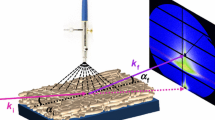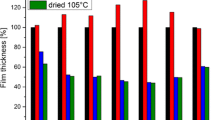Abstract
An optimization study of the preparation of spin-coated cellulose model films from the NMMO/DMSO system on silicon wafers has been made. The study shows that the cellulose concentration ID the solution determines the cellulose film thickness and that the temperature of the solution affects the surface roughness. A lower solution temperature results ID a lower surface roughness at cellulose concentrations below 0.8%. Using the described method, ID ID possible to prepare films with thicknesses of 30–90 nm with a constant surface roughness by changing the cellulose concentration, i.e. by dilution with DMSO. On these films, water has a contact angle less than 20° and about 50% of the material can, according to CP/MAS 13C-NMR spectroscopy on corresponding fibrous material, be considered to consist of crystalline cellulose ID type material. ID has further been shown that AFM can be used to determine the thickness of cellulose films, ID both dry and wet states. ID this method, the difference ID height between the top surface and the underlying wafer has been measured at an incision made into the cellulose film. The cellulose films have also been spin-coated with the same technique as on the silicon oxide wafer onto the crystal ID a quartz crystal microbalance (QCM). These model films were found to be suitable for swelling measurements with the QCM. The films were very stable during this type of measurement and films with different amounts of charges gave different swelling responses depending on their charges. As expected, films with a higher charge showed a higher swelling.
Similar content being viewed by others
References
Arndt K.-F., Morgenstern B. and Röder T. 2000. Scattering function of non-substituted cellulose dissolved ID β-methylmorpholine-β-oxide-monohydrate. Macromol. Symp. 162: 109-119.
Dijt J.C., Cohen-Stuart M.A., Hofman J.E. and Fleer G.J. 1990. Kinetics of polymer adsorption ID stagnation point flow. Colloids Surf. 51: 141-158.
Edgar C. and Gray D. 2002. Creating model cellulose I surfaces from nanocrystal suspensions. Abstracts of papers, 223rd ACS National meeting, Orlando, FL, April 7-11.
Flory P.J. 1953. Principles of Polymer Chemistry. Cornell University Press, Ithaca, NY.
Gunnars S., Waġberg L. and Cohen-Stuart M.A. 2002. Model films of cellulose ID Method development and initial results. Cellulose 9: 239-249.
Hearle J.W.S. 2001. ID: Woodings C. (ed.), Regenerated Cellulose Fibres. CRC Press, Woodhead Publishing Ltd, Cambridge, UK, pp. 199-234.
Holmberg M., Wigren R., Erlandson R. and Claesson P.M. 1997a. Interactions between cellulose and colloidal silica ID the presence of polyelectrolytes. Colloids Surf. 129-130: 175-183.
Holmberg M., Berg J., Stemme S., Ödberg L., Rasmusson J. and Cleasson P. 1997b. Surface force studies of Langmuir-Blodgett cellulose films. J. Colloid Interface Sci. 186: 369-381.
Höök F., Rodahl M., Brzezinski P. and Kasemo B. 1998. Energy dissipation kinetics for protein and antibody-antigen adsorption under shear oscillation on a quartz crystal microbalance. Langmuir 14: 729-734.
Huang Y., Gardner D., Chen M. and Biermann C. 1995. Surface energetics and acid-base character of sized and unsized paper handsheets. J. Adhesion Sci. Technol. 9(11): 1403-1411.
Israelachvili J.N. and Adams G.E. 1978. Measurement of forces betweentwomica surfaces I aqueouselectrolyte solution ID the range 0-100 nm. J. Chem. Soc. Faraday Trans. I 74: 975-1001.
Jayme G. 1958. Properties of wood celluloses ID Determination and significance of water retention value. Tappi 41(11): 180A-183A.
Katz S., Beatson R.P. and Scallan A.M. 1984. The determination of strong and weak acid groups ID sulfite pulps. Svensk Papperstidn. 87(6): R48-R53.
Lennholm H. and Iversen T. 1995. Estimation of cellulose I and ID ID cellulosic samples by principal component analysis of 13C-CP/MAS-NMR-spectra. Holzforschung 49: 119-126.
Lennholm H., Larsson T. and Iversen T. 1994. Determination of cellulose ID and ID#x03B2; ID lignocellulosic materials. Carbohydr. Res. 261: 119-131.
Lindström T. and Carlsson G. 1982. The effect of carboxyl groups and their ionic form during drying on the hornification of cellulose fibres. Svensk Papperstidn. 85(15): R146-151.
Nelson P.F. and Kalkipsakis C.G. 1964. The behavior of salts of a carboxymethylated eucalypt kraft pulp. Tappi 47(3): 170-176.
Neuman R.D., Berg J.M. and Cleasson P.M. 1993. Direct measurement of surface forces ID papermaking and paper coating systems. Nord Pulp Pap. Res. J. 8: 96-104.
Pettersson B. and Eriksson K.-E.L. 2000. A standardized spectrophotometric assay of endoglucanase activity using dyed amorphous polysaccharides. Anal. Biochem. 285: 220-224.
Poptoshev E. 2001. Polyelectrolyte moderated interactions between glass and cellulose surfaces. PhD thesis, Royal Institute of Technology (KTH), Stockholm, Sweden.
Revol J.-F., Godbout L. and Gray D.G. 1998. Solid self-assembled films of cellulose with chiral nematic order and optically variable properties. J. Pulp Paper Sci. 24(5): 146-149.
Rodahl M., Höök F., Krozer A., Brzezinski P. and Kasemo B. 1995. Quartz crystal microbalance setup for frequency and Q-factor measurements ID gaseous and liquid environments. Rev. Sci. Instrum. 66(7): 3924.
Rodahl M. and Kasemo B. 1996. A simple setup to simultaneously measure the resonant frequency and the absolute dissipation factor of a quartz crystal microbalance. Rev. Sci. Instrum. 67(9): 3238-3241.
Rodahl M., Höök F., Fredriksson C., Keller C.A., Krozer A., Brzezinski P., Voinova M. and Kasemo B. 1997. Simultaneous frequency and dissipation factor QCM measurements of biomolecular adsorption and cell adhesion. Faraday Discuss. 107: 229-246.
Röder T. and Morgenstern B. 1999. The influence of activation on the solution state of cellulose dissolved ID N-methylmorpholine-N-oxide-monohydrate. Polymer 40: 4143-4147.
Röder T., Morgenstern B. and Glatter O. 2000. Polarized and depolarized light scattering on solutions of cellulose ID N,N-dimethylacetamide/lithium chloride. Macromol. Symp. 162: 87-93.
Röder T., Morgenstern B., Schelosky N. and Glatter O. 2001. Solutions of cellulose ID N,N-dimethylacetamide/lithium chloride studied by light scattering methods. Polymer 42: 6765-6773.
Torn L.H. 2000. Polymers and surfactants ID solution and at interfaces. PhD thesis, Wageningen University, The Netherlands.
Wågberg L. and Westerlind C. 2001. Spreading of droplets of different liquids on specially structured papers. Nord. Pulp Pap. Res. J. 5: 598-606.
Walecka J.A. 1956. An investigation of low degree of substitution carboxymethylcelluloses. Tappi 39(7): 458-463.
Westman L. and Lindström T. 1981. Swelling and mechanical properties of cellulose hydrogels. 1. Preparation, characterization and swelling bahavior. J. Appl. Polym. Sci. 26(8): 2519-2532.
Woodings C. 2001. Regenerated Cellulose Fibres. CRC Press, Woodhead Publishing Ltd, Cambridge, UK, pp. 1-21.
Author information
Authors and Affiliations
Rights and permissions
About this article
Cite this article
Fält, S., Wågberg, L., Vesterlind, EL. et al. Model films of cellulose ID – improved preparation method and characterization of the cellulose film. Cellulose 11, 151–162 (2004). https://doi.org/10.1023/B:CELL.0000025403.23775.75
Issue Date:
DOI: https://doi.org/10.1023/B:CELL.0000025403.23775.75




